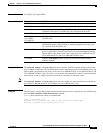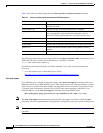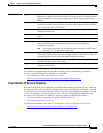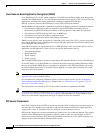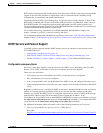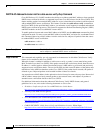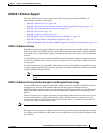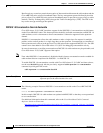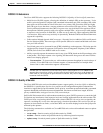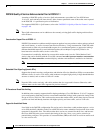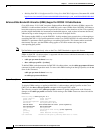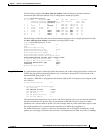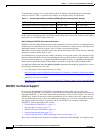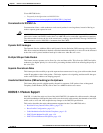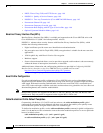
1-51
Cisco uBR7200 Series Universal Broadband Router Software Configuration Guide
OL-2239-05
Chapter1 Overview of Cisco uBR7200 Series Software
Supported Software Features for the Cisco uBR7200 Series
DOCSIS 1.0 Extensions
The CiscouBR7200series supports the following DOCSIS 1.0 Quality of Service (QoS) extensions:
• Multi-Service ID (SID) support, allowing the definition of multiple SIDs on the upstream—Voice
traffic can be designated on a higher QoS committed information rate (CIR) secondary SID, while
data traffic can be forwarded on a best-effort basis on a primary SID. Secondary SIDs are higher
QoS CIR-type classes that have a nonzero minimum reserved rate (CIR-type service). These SIDs
receive preferential treatment at the CMTS for grants over any tiered best-effort type data SID of
that upstream. Reliable operation with voice requires multiple SIDs—at least two per cable modem
to separate voice from data. In DOCSIS 1.0, SIDs are set up statically. When supporting DOCSIS
1.0 extensions, SIDs can be set up statically or dynamically. Both the CMTS and cable modem must
support this capability.
• Cable modem-initiated dynamic MAC messages—Dynamic Service Addition (DSA) and Dynamic
Service Deletion (DSD). These messages allow dynamic SIDs to be created and deleted at run-time
on a per-VoIP call basis.
• Unsolicited grant service (constant bit rate [CBR] scheduling) on the upstream—This helps provide
a higher-quality channel for upstream VoIP packets from an Integrated Telephony Cable Modem
(ITCM) such as the CiscouBR924 cable access router.
• Ability to provide separate downstream rates for any given ITCM, based on the IP-precedence value
in the packet—This helps separate voice signaling and data traffic that goes to the same ITCM to
address rate-shaping purposes.
–
Concatenation—To increase the per- cable modem upstream throughput in certain releases of
software, CiscouBR7200series software supports a concatenated burst of multiple MAC
frames from a cable modem that supports concatenation.
Note All DOCSIS 1.0 extensions are activated only when a cable modem or CiscouBR924 that
supports these extensions solicits services using dynamic MAC messages or the feature set.
If the CMs in your network are pure DOCSIS 1.0-based, they receive regular DOCSIS 1.0
treatment from the CMTS.
DOCSIS 1.0 Quality of Service
The Cisco uBR7200 series universal broadband routers support quality of service (QoS) as defined by
the DOCSIS 1.0 specification. Service class profiles can be configured through the command-line
interface to support the QoS profile number, traffic priority, maximum upstream bandwidth, guaranteed
upstream bandwidth, maximum downstream bandwidth, maximum transmit burst length, baseline
privacy enable/disable, and type of service (ToS) overwrite byte.
QoS Profile Enforcement allows cable modem termination system (CMTS) operators to control the QoS
to eliminate any interference from improper local-rate limiting implemented on the cable modem. The
CMTS provisions a registering cable modem with a default DOCSIS 1.0 service class assigned by the
operator, overriding any service class that previously existed on the modem. This service class has no
upstream or downstream rate limits, so that the CMTS can do traffic shaping based on the QoS profile
enforced by the operator.
The following commands are available on Cisco uBR7200 series universal broadband routers to update
the QoS table:
• create-snmp—Permits creation of QoS table entries by SNMP.
• modems—Permits creation of QoS table entries by modem registration requests.
• update-snmp—Permits dynamic update of QoS table entries by SNMP.



